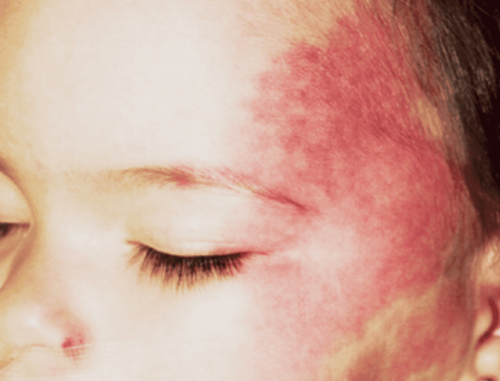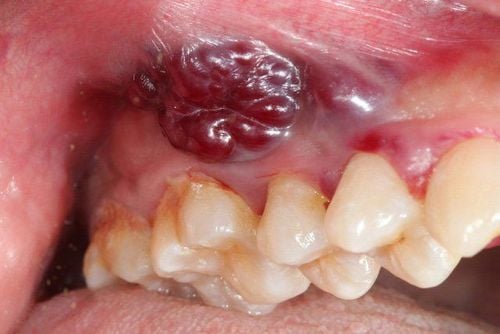This is an automatically translated article.
Hemangiomas and lymphomas are both benign noncancerous tumors. Tumors often appear on the skin in common locations such as face, head, neck... They will be recommended surgically removed to avoid affecting the body's aesthetics as well as unnecessary effects. relevant to the patient's daily life.
1. What is hemangioma?
Hemangioma is a benign (noncancerous) tumor made up of small blood vessels that multiply at an abnormal rate. There are many types of hemangiomas and they occur throughout the body including the skin, muscles, bones, and internal organs. Most hemangiomas occur on the surface of the skin. When they develop on the face and neck, these tumors come in a variety of colors, shapes, and sizes. Hemangiomas very rarely become cancerous, but some hemangiomas can be disfiguring and require medical intervention. Hemangiomas that require surgery include tumors deep in the muscles, bones, or skin tumors that cause problems with vision, breathing or eating.
U máu thường xảy ra ở trên bề mặt da
Different hemangiomas are associated with different causes. Example: Neonatal hemangioma is caused by faulty functioning of the vascular system during fetal development. Either some hemangiomas are caused by an injury, or some hemangiomas are genetically related (Hippel-Lindau disease)...
Hemangiomas are usually painless, red to blue-colored lesions on the skin and lips or in the mouth. They are usually soft to the touch. Superficial lesions may bleed or turn into ulcers, especially if bumped or injured. Hemangiomas deep in the muscle can cause pain and swelling.
2. Lymphoma
Lymphoma is a deformity of the lymphatic system characterized by thin-walled cystic lesions. The lymphatic system is the network of vessels responsible for removing excess fluid from the venous system from tissues, as well as the lymph nodes that filter this fluid for signs of pathogens.
Lymphomas can occur at any age and involve any part of the body, but 90% occur in children under 2 years of age and are usually located on the head and neck. Lymphomas may be congenital or acquired. Congenital lymphomas are often chromosome-associated such as Turner syndrome. Congenital tumors are usually diagnosed before birth by fetal ultrasound. Acquired lymphangiomas can be caused by trauma, inflammation, or a lymphatic blockage.
Most lymphomas are benign and localized to one or more areas of the body. Symptoms of the disease depend on the size and location of the tumor. Lymphomas may appear as small red or blue dots. When lymph accumulates, it can swell and cause disfigurement. Depending on where the swelling is, tissue or organs are affected and cause serious health problems. For example, a swollen tongue can make it difficult to speak and eat. Or a lymphoma in the eye socket can cause double vision...

U bạch huyết khu trú ở nhiều khu vực trên cơ thể
3. Surgical treatments
Surgery will be indicated for hemangiomas, lymphomas with a diameter of 5-10cm. These are tumors that cause entanglement, affecting life function or aesthetics.
3.1. Surgical removal of hemangiomas Depending on the size of the tumor and its location, there are several possible treatment options. Surgery is recommended for hemangiomas that have a complex structure and are in progress that threaten to destroy surrounding healthy tissue. These cases often cause severe pain that warrants consideration for surgical treatment.
The surgical procedure to remove melanoma will use general anesthesia to put the patient to sleep. The doctor will then make an incision in the skin and remove the tumor.
The patient may have stitches after the doctor removes the tumor. The doctor will wrap this area with a compression bandage and give specific instructions for the patient to care for the wound to recover quickly.
The most common complication of hemangioma surgery is bleeding. In addition, hemangiomas have a high tendency to recur after surgery. And the condition will depend on the type and location of the tumor.
3.2. Lymphoma surgery The most common treatment for patients with lymphoma is complete surgical resection. Because the pits under the skin must be removed to prevent the lesion from reappearing. Local recurrence is common in lymphomas. Therefore, total resection of this tumor can be difficult and sometimes not feasible. Tumors that are confined to the dermis can be easily removed during surgery and the success rate of surgery is very high.
Lymphomas don't cause any problems, but because of their protrusion on the face and neck, they can affect a person's appearance. In addition, it can also have serious complications such as: pain, infection, difficulty breathing, swallowing, cellulitis, bleeding, chest pain,...
Hemangiomas and lymphomas are both present. may adversely affect the patient's quality of life. These effects include deformities on the body, especially in the face and neck area. Therefore, patients need to be examined by specialists to find an effective treatment for each specific case.
To register for examination and treatment at Vinmec International General Hospital, you can contact Vinmec Health System nationwide, or register online HERE
recommended video:
Health check periodic health at Vinmec: Protect yourself before it's too late!
MORE
Diagnosis of lymphoma by ultrasound Is hemangioma in children dangerous? Common types of subcutaneous hemangiomas













